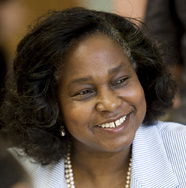Meeting the needs of generations spanning over 55 years
By Lynette Chappell-Williams Phyllis Weiss Haserot

This article is the second in a series of Cornell Perspectives on diversity and inclusiveness concerns that will appear periodically in the Cornell Chronicle.
As Cornell strives to meet the needs of its workforce through its strategic plan for diversity, it is addressing the very different concerns of four generations: the traditional or builders (born prior to 1945, currently 52 million people nationally), the baby boomers (born 1946-64, currently 77 million), Generation X (born 1965-79, 65 million) and millennials, or Generation Y, (born 1979-2000, with 80 million people). And before too long, Gen 2020 (born after 1997) will be entering the workforce.
For Cornell to be successful as an employer of choice for a diverse workforce, it's recruitment and retention strategies have to be effective and relevant to four generations spanning more than half a century.
At Cornell, as in the nation as a whole, the major group in the workforce is 55 and older. In a 2009 study, the Pew Research Center predicted that between 2006 and 2016, 93 percent of the growth in the U.S. labor force will be among baby boomers, as older adults stay in the labor force longer and younger adults stay out of it longer. These trends have intensified during the recession and are expected to continue as the economy recovers.
Currently 11.27 percent of Cornell's combined faculty and staff workforce falls into the millennial group, with the predominant group, 45.24 percent, being baby boomers, somewhat ahead of Generation X employees at 38.2 percent. However, 52.53 percent of faculty members are baby boomers, and a mere 1 percent are in Generation Y.
Like other employers, Cornell needs to confront the reality that a major portion of its labor force, both faculty and staff, will be eligible for retirement over the next decade, resulting in the need for a significant knowledge transfer.
As departments recruit a multigenerational workforce, they need to focus on their messages and branding to appeal to all four generations:
Thus, as we focus more on retention and engagement of faculty and staff, the generational perspective is particularly important. One initiative that has cross appeal, regardless of the generational group, is work-life flexibility in the workplace. A recent U.S. study found that respondents who have access to formal flexible work options and family-care support are significantly more likely to believe that their employer will provide them with opportunities to learn and grow as well as to advance.
The working relationship with the manager/supervisor also significantly affects the retention of members of all generations. Cornell Human Resources is positioning managers to be more effective through a recently redesigned Performance Management Program and through expanded options for professional development.
Perhaps the greatest challenge is creating the right climate for the needs of an older workforce as well as the younger. Samuel Bacharach, ILR's McKelvey-Grant Professor in the Department of Organizational Behavior, shared this thought in The Bacharach Blog on Feb. 11: "Some of the qualitative data collected from … older workers suggest that social relations with coworkers and patterns of work-based social support play a pivotal role when retirement-eligible workers make the decision to throw in the towel or not."
As Cornell works towards the implementation of its strategic plan for diversity, aligning the needs of the multigenerational workforce will be a priority. The next article in this series will look at some of the initiatives to help Cornell address this priority.
Lynette Chappell-Williams is associate vice president for workforce diversity and inclusion. Phyllis Weiss Haserot '65, MRP '67, a member of the University Council and the President's Council of Cornell Women, is president and founder of Practice Development Counsel, a business development and organizational-effectiveness consulting firm.
Media Contact
Get Cornell news delivered right to your inbox.
Subscribe